Image Credit: Kent Earle
Editor’s note: Kent Earle and his wife, Darcie, write a blog called Blue Heron EcoHaus, documenting their journey “from urbanites to ruralites” and the construction of a superinsulated house on the Canadian prairies. Their previous blog on GBA was called Placing the Concrete Floors. The blog below was originally published in August 2015. (A complete list of Kent Earle’s GBA blogs is provided in the “Related articles” sidebar below.)
We knew we wanted a black house. In fact, when designing the house, it was one of the only things that really remained consistent and we didn’t change our minds about. (OK, truthfully, we strayed a little bit — testing the waters. But as they say, once you go black, you probably won’t go back… or something like that.)
Our previous house had been painted black by the previous owners (we are soul mates) and we loved it dearly. But really, we did not want to simply paint our new house black. Paint is great for covering up years of other layers of toxic paint, as at our old house, but not as an initial coat. So, what to do?
In the process of researching, planning, and designing the house, we collected hundreds of inspiration pictures. The majority of my “architecture” folder on Pinterest is of black houses. I’d look at each one and try to figure out what they used: paint, stain, or something else?
One of the first “something else” options we were initially really drawn to was the traditional Japanese siding treatment called shou sugi ban. An article posted at Treehugger said: “This is a traditional Japanese method of preserving cedar, where it is burned enough to create a layer of char on the outside. The char serves a number of functions: it seals and preserves the wood, it makes it significantly more fire-resistant, and termites and bugs hate it.”
It is said that this type of treatment can allow the wood to survive for 80 to 100 years without maintenance and much longer if treated with oil every 15 years.
A video of the traditional process in Japan.
OK, so just imagine doing that 200 times over to clad your moderately sized house. Now that is labor intensive! Most people nowadays, from what I’ve read, use a blowtorch to char each board, then dunk it in water, scrub the charred bits off, and then oil it. Even with a blowtorch, this a crazy amount of work, but in the end you get something really impressive and unique.
Let’s find a more reasonable alternative
I really thought we were going to do this for our place. However, there were a few reasons we abandoned this idea. Firstly was the obvious: OMG, that would be so much work! Second, cedar is crazy expensive right now, running in the range of $7 to $9 per square foot. But the final reason was that we had heard that someone had decided to do a house in shou sugi ban in the City.
Curious to see it in real life, we drove over to take a look. And well, to be honest, we really hated it. Perhaps it was just that the people who did it did a bad job, but it looked really… gross. It basically looked like a house that had had a fire recently go through it (which I suppose is true). I think I would like to test it out on a shed or coffee table or something before I invest thousands of dollars in the siding of my house and ended up hating myself over it.
So, we turned to the natural (and perhaps most obvious) option: stain. Stain is all well and good, but you really need to stain your wood every five years (or less) to preserve the wood and keep it looking good. And really, you still should use cedar to have optimal rot protection with plain old stain. That’s what we thought, at least, until my wife came across a little black Swedish house called House Morran.
Granted, this house is actually sided in plywood, which I would never do, but what intrigued me was the rich black color, and the fact that the grain of the wood still came through (unlike with painted siding), and that they had used a siding that was not cedar.
As I read more about this house, I discovered that they used “black tar” for the siding. Through some detective work, we eventually found this same house linked to a Swedish product called Auson black pine tar.
I had never heard of or seen this product before, but I was very intrigued. Also, it was Swedish, and seeing as our house had a lot of Scandinavian inspiration, this only seemed fitting.
We found that the product was available in Canada through a website called Solvent-Free Paint. Score. We emailed the company to learn a bit more about it:
An all-natural product
We corresponded with John Sinclair at Solvent-Free Paint, the Canadian distributor, who wrote, “Genuine Pine Tar is one of the more effective wood preservers we’ve seen, and it is all-natural, which is amazing. In Scandinavia, they have been using pine tar for around 1,500 years as a preservative on everything from stave wood churches to wooden splint roofs to Viking ships, and it is still the predominant choice for continuing to preserve these old wooden structures to this day. Amazing. In fact, the heritage arm of the government of Québec has been making studies on this with respect to preserving wooden roofs, and its current recommendation is to use pine tar.
“Pine tar is made from burning the pine resin out of the stumps of pine trees. The sticky resin is then collected and cleaned to various degrees, and pigment is added for color. In this state, pine tar has the consistency of molasses and can be used for preserving wood, even below grade. Above grade, we recommend mixing pine tar 50/50 with Allback Purified Raw Linseed Oil and applying it warm so that the pine tar and oil mixture really penetrates the wood. This mixture offers the best of both preservation and nourishment for the wood; it also takes down the stickiness of the surface so that it is more pleasant to touch or walk on.”
Even better, this product is ideal for use in Scandinavia, where pine and spruce are much more readily available and cedar is not. It preserves the wood and needs to be recoated only once every 15 years.
Bingo, we’d found our product. We ordered a few liters of this stuff. We had debated about using cedar for our soffits as well, but once we saw this, we realized we could use pine lumber treated with a natural clear pine tar for much less than half the cost of cedar.
Soffits come first
We started with the soffits, which would be easiest to install first. Yes, it is true that most people use aluminum or vinyl vented soffits, which are foolproof but also so incredibly boring. Instead, we purchased 1×6 tongue-and-groove white pine.
Now, one thing you need to know about staining (or painting) wood for siding or soffits, is that you mustn’t let any part of the wood be left untreated (otherwise the lifespan of the wood will drop by 50% to 75%, so preparation is key)! That is, you must stain all six sides of the wood. For the tongue-and-groove pine, this meant that, yes, we had to stain the tongue and the groove, which is a crazy, tedious, and annoying task.

We had about 800 square feet of soffit to stain on all sides — twice. It took us about 14 hours, but it looked pretty nice by the time we were done. The pine tar was actually easier to use than we expected. Once mixed 50/50 with the linseed oil, it was really just like a slightly thickened stain. It brushed on easy and evenly.
However, we had to keep it warm. On the hot 30°C (86°F) days, it was easy, but on the cooler days we had to heat it up on the stove in the shop. Also, each coat took between four and seven days to dry, and even then it still had a bit of residue on it that, hopefully, will dry someday. Surprisingly, it was not at all sticky. (I had fears of moths and dust sticking to the house.)
As for venting the soffits, there is a calculation of square footage of ventilation versus square footage of attic space which is approximately 1 square foot of venting to every 100 square feet of attic. We figured a gap of about 3/4 inches by 30 inches lengthwise along every fourth board would be about right. We used a router to cut the gaps and covered it with a bug screen.
I was so impressed with how well these boards turned out. Much better than I’d expected, to be honest.
Next up was the siding, which I was most excited about. We ordered the tight-knot white pine siding as a “shiplap reveal” in 1×8. That pile took a ridiculous amount of time for us to work through. I had expected it to go relatively quickly, seeing as we did not have to stain a stupid groove, but 30 hours later we were finally done.
We were exhausted, but man, did it look badass. (See the photo below.)
Weekly Newsletter
Get building science and energy efficiency advice, plus special offers, in your inbox.

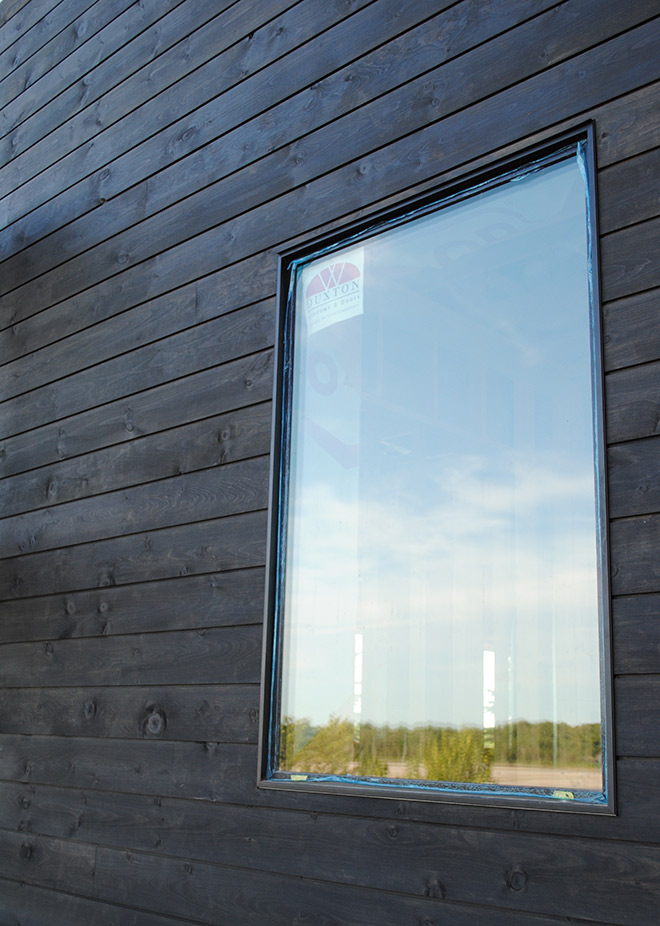




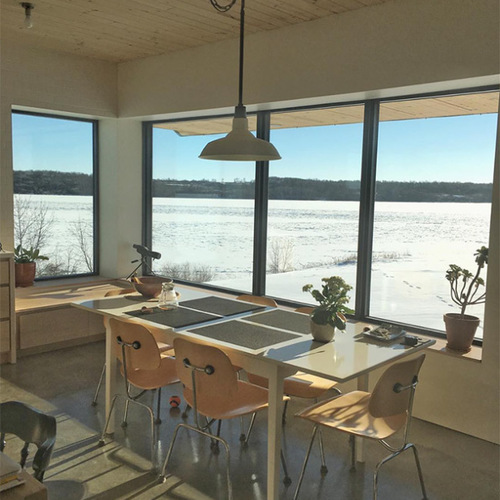
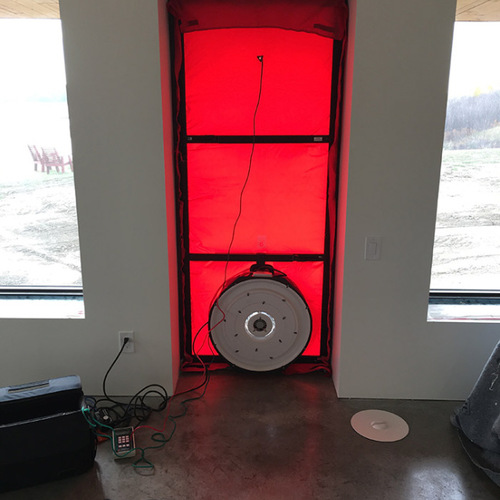
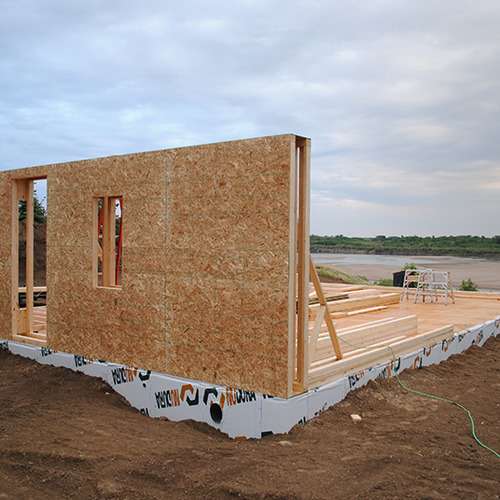
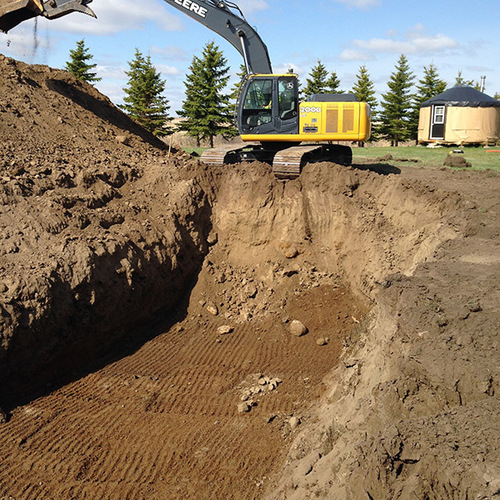
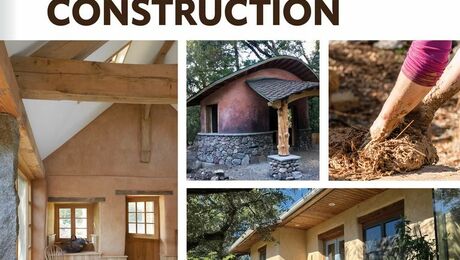

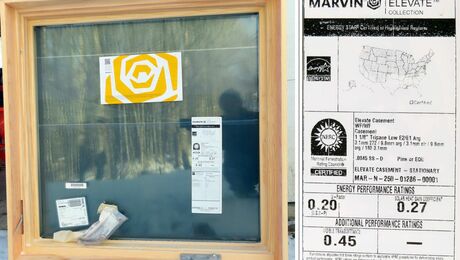
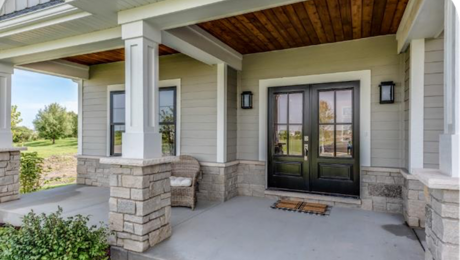
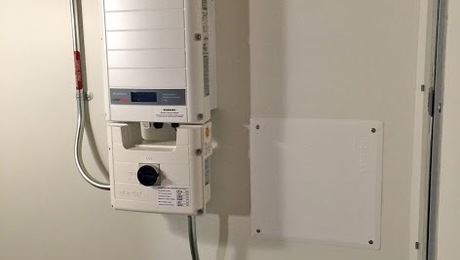

19 Comments
Siding
Kent: The siding looks nice. One issue with the shou sugi ban is that it is a real mess to install, with soot getting all over the place. Does the pine tar treatment rub off?
A minor quibble- That isn't clear pine, it looks like #2 common. Around here in Maine, the Pine Tree State, clear pine costs at least double the price of #2.
Spraying
@Kent. Great post. I think we have similar aesthetic tastes.
I was considering shou sugi ban for my next house but am glad to see there is a less expensive and labor-intensive option. Do you know if the pine tar mix can be sprayed? That would certainly speed up the process.
exterior stain seems to last
Thanks, that is a neat idea.
As to stain, I have done a lot of exterior stain on wood fencing. It has lasted well over a decade with no apparent fading. At least on the sides. I don't check the top of the fence often so it may have faded there.
I buy the highest priced stain from a big box store, made by Pittsburgh Paints.
Pine siding
Stephen - Thanks for your comments. The pine tar is a bit messy to install as well, particularly the black as it had not fully cured when they were installing it. highly recommend wearing vinyl or rubber gloves when working with it. I would say it took about 2 months before it fully cured. Before this, even when touching it your finger, you would get a residue of black (don't lean against it with a new white shirt!). But this did not seem to affect the wood itself (eg. leave hand prints) - it seemed that the pine tar had penetrated the wood well enough that handling it did not at all change the finish on the boards.
I also double-checked and you are correct. My apologies. This is "tight knot pine", not clear pine. We had used the clear fir inside but not outside. I've asked the editor to correct this in the post.
Steve - I'm pretty sure it needs to be brushed on, but it would not hurt to email the Solvent Free Paint company and ask - they are very helpful.
Flammability?
Does anyone know if this increases concerns of flammability for the siding? I really like the color of pine tar stain but since it's so uncommon in the US I worry about using it for the house. I don't know if there are problems with using it which is why it's not used at all here.
Pine
Kent: I think having some knots makes for a much more attractive look for anything being stained. Here we often use clear pine for trim, but it's pricy.
I put in 2x6 pine with tight knots as roof sheathing for an exterior open porch and it looks good. Same in our hot tub room.
A friend installed shou sugi ban as exterior siding and is pleased with it. It was astonishingly messy to apply, though.
Keep the reports coming. The house is terrific.
Labor savings vs. Shou Sugi Ban?
I noticed that you speculate this pine tar stain is less labor intensive than burning the wood (whether with a torch or traditionally). You also mentioned that it took you 13 hours to stain 800sqft of your T+G siding. This seems like a lot more time, in fact, than my rough estimates come out to for burning all sides of boards with a torch (I estimate one person with a torch could burn approximately 150sqft of siding in an hour--let's ignore fuel refilling time for the moment--that would mean burning >5sqft surface per minute).
I'm not so interested in being right on this--more to the point, I'm wondering whether I'm completely off base in my estimates? Has anybody done a large amount of burning with a torch and have a decent idea of how long it took per unit of surface? I like how your pine tar stain looks, but I still am enchanted by a product which doesn't need to be maintained for 50-100 years... sorry if I'm hijacking here, but it seems apt.
Maintenance
If I'm interpreting your statements above correctly you mention that it only needs to be re-coated every 15 years. If I'm looking at the right product on the solvent free website they recommend re coating with linseed oil every 3-5 years. I really like everything about this but am trying to avoid regular maint. Every 15 years is great 10 years would even be pretty good, but 3-5 years is about the same as any regular stain if I'm not mistaken. Am I missing something?
Messy and smelly, but beautiful
We have specified the black pine tar stain on a couple of projects, and I will be using it on my house because nothing else compares to the look. So far all I've done is the fascia boards because it has been raining for 3 months, but I digress. On the recommendation of the folks who used it on our previous projects, I will be staining the siding in place, post installation. It will only get stain on the exposed surfaces, but after staining the soffits, I decided there was no way I'd subject my carpenters to a whole house worth of siding covered with the stuff. It doesn't dry for months, as you stated, and the black gets on everything: Hands first, then subsequently your clothes, saws, nailers...everything.
In discussing it with the installers on another job I expressed concern that as the shiplap siding shrunk, the gaps would open up and then the house would be striped with stained faces and unstained laps. He said that when the stain is heated and applied liberally, it really soaks in and draws into the joints. The installation instructions encourage brushing it on to work it in, so I am not sure a spray application would work well unless you brush it after spraying.
Since our siding has been installed for a few months while it rains every couple of days, the shiplap gaps have already started to open up a bit. I think if I apply it with a good brush, and work it liberally into the joints, it should cover well. I'll let everyone know how it goes and how it looks after a year or two. I was less concerned about "6-sided coverage" since the siding is cedar and has a 1/2" rainscreen gap behind it.
An installation tip from our projects is to get two cheap crock pots from a re-use store (or your own kitchen if you want to buy a new crock pot for your food). Heat your mixed stain/linseed oil in one pot. Use that pot to stain your siding while the second pot heats up the next mixed batch.
Lastly it should be mention that this stuff is SMELLY. Maybe it isn't any more smelly than an oil based stain, but you will smell it for a long time after you are done applying it. One of our carpenters said his mother asked him if he had been smoking fish because he reeked of it.
All that said, it really is a beautiful finish, and sometimes the hassle is worth it.
Pine tar
Clara - Flammability is not an issue. The pine tar is made from resin of burned trees, so it has already burned, so to speak. We threw a few scrap pieces of the stained boards in the outdoor fire awhile back and it burned for an exceptionally long time. I'd read somewhere that there is some flame retardability with pine tar and my little care study seemed to work.
Jonathan - good point. My assumption and from reading what others had done with shou sugi ban - it seemed very labour intensive, although I have never done it. So I couldn't really compare. Staining all sides of the siding, in the end also took a long time. So who knows? In the end though, it came down to the fact that we liked the finish of the black pine tar better than the shou sugi ban (and we could use pine wood instead of cedar). If we'd liked the shou sugi ban look better, then this post would have been about that process instead! Everything takes time and often longer then expected, so I'd do whichever you like better.
Olson - Everything I came across with pine tar suggested about a 15 year time frame for recoating, which I could live with. 3-5 years would be disappointing and as you said the same as regular lumber store stain. Check out this: http://www.solventfreepaint.ca/info/case_study_shingles.htm Wood shingles have harsher exposure than siding, so I'd be surprised if siding would not hold up just as well.
Elden - Yes, I forgot to mention that it is smelly! It smells like campfire. So make sure you do it in a ventilated area. Once it was installed, the smell was only slightly noticeable for a couple weeks. We used a 1x8 shiplap reveal and have not had any issues with shrinkage (I've attached the profile of the boards we used). Although the moisture content when you stain it would have an effect. We stained it when it was around 14% moisture, which is what the distributor had recommended to us.
Clarification?
Fantastic article and results! Thanks for sharing!
Just to be clear, did you mix the black pine tar (http://www.solventfreepaint.ca/pine-tar.htm) with the black Allback Linseed Paint (http://www.solventfreepaint.ca/linseed_paint.htm) to get your colour for the siding? And for the soffits did you use a lighter tone of each in mixture?
And could one just apply the Linseed Paint on the back of the boards, and only do the pine tar and linseed mixture on the face and edges? Thanks again for sharing- I really, really like the economy, look and durability of the product and process. Wonder how it would stand up to west coast weather, where oild and mildew spores are more likely to stick to the very matte finish of the siding, which can be an ongoing problem on north faces out here . . .
Burke
No, we mixed 50/50 the Black pine tar (http://www.solventfreepaint.ca/pine-tar.htm) with Purified Linseed Oil (http://www.solventfreepaint.ca/cleaned_linseed_oil.htm). This needs to be warm when applied. The Linseed paint is different and we did not use this.
The Pine tar is black - it is just very thick, like molasses. But when thinned with the linseed oil, which really has no color contribution, it goes on like a slightly thick stain.
For the soffits, we used 50/50 "Natural" pine tar with purified linseed oil.
For the soffits, which we did first, I thought it would be easier to just paint the back side with a primer exterior paint - but this was such a mess! It was hard to not get some of the white primer on the front of the boards, so I ended up having to sand some of the paint off the front and this so annoying. As such, for the siding we just did all 6 sides with the 50/50 mix of black pine tar and linseed oil. It went on well and then we did not have to worry about not being messy.
I don't know about the west coast weather - might be something to test out. We've had no issues with anything sticking to the matte finish and it has now been up for over a year.
Linseed oil
Ten years ago I used only "raw ", as opposed to boiled, linseed oil on spruce siding. A friend suggested adding pine tar, but I preferred a natural wood color, as you used on your soffits. Another friend warned me the linseed oil would feed mildew, and he was quite correct. Soon enough there were black stains everywhere. I didn't want to recoat with linseed oil and just add to the problem. If I still owned the house I would definitely go back with pine tar mix. It looks great. I assume the 'purified' linseed oil you used is not heated to polymerize the oil just judging from the time it takes to cure.
hot climate ?
In Southern California, there are a few very hot months. Temps can be over 100F. Is this suitable for a small addition (a closet) to my garage? What maintenance would be required? It looks awesome and so VERY interesting!!
Thank you,
Lynne
Lynne
I don't see why the 100F would be a problem at all. Maintenance is minimal - recoat every 15 years or so. We ordered this through solventfreepaint.ca (solventfreepaint.com in the USA). The customer service people are a wealth of information.
Exterior finish
Hi
Very nice project. Do you have any photos of the exterior as is it today. I am curious how it has weathered and if you had to screw it instead of nailing it to prevent cupping.
Thanks
vapor barrier?
Solventfreepaint.com says "Pine Tar has been used since ancient times for creating a water repellent vapor barrier on wood and rope and for its gentle antiseptic effect. Pine Tar is used for wood preservation on utility and fence poles, cottages, splint roofs, boats et cetera."
Could you inadvertantly be creating a double vapor barrier with this product? Or perhaps they just mean to say WRB.
How is this siding attached without face nailing. As I understand it, it's ship lap, and not tongue and groove.
Looks gorgeous, especially with the texture of the knots.
Dear Kent,
I feel so fortunate to have stumbled upon your article as I am currently residing my home and am currently fighting an uphill battle with everyone to convince them on black stained cedar or pine siding. They're right. Who wants to restain every 3-5yrs? But nothing comes close to the look, feel, and eco-friendliness of sustainably harvested wood. We use pine tar here on the farm and I had been wondering if it could be used to stain wood, and here you are answering my question!
It's been 3 years now, how is it holding up? Has it faded? Would you mind posting more pictures?
Thank you for giving all us lovers of dark stained real wood siding hope!
Breanna
Log in or create an account to post a comment.
Sign up Log in